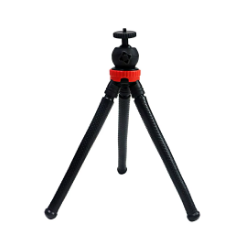An octopus tripod (also called a flexible tripod) is a versatile tool for photographers and videographers, offering unique adaptability in challenging environments. Unlike traditional tripods, its flexible legs can wrap around objects or adjust to uneven surfaces, making it ideal for creative angles and on-the-go shooting. Here’s a comprehensive guide to maximizing its potential, with practical examples from MILIBOO’s octopus tripod series.
1. Basic Setup: Unlocking Flexibility
Before diving into advanced techniques, familiarize yourself with your octopus tripod’s core features.
- Leg Adjustment: The flexible legs of a MILIBOO octopus tripod (e.g., MILIBOO MZ02) are reinforced with TPR rubber and aluminum alloy cores, ensuring both durability and bendability. Twist the legs gently to mold them around poles, branches, or rocks.
- Quick Mounting: Attach your camera or smartphone to the 360° ball head, which allows smooth panning and tilting. The MILIBOO MZ02 includes a universal phone clamp and Bluetooth remote for hands-free control.
2. Creative Placement: Think Beyond Flat Surfaces
The octopus tripod shines in unconventional scenarios.
- Wrap-and-Shoot: Secure the tripod to railings, tree trunks, or street signs. For example, the MILIBOO Travel Series legs feature anti-slip silicone pads to prevent slippage on smooth surfaces.
- Low-Angle Shots: Bend the legs into a compact “spider” shape for ground-level perspectives. The MILIBOO Compact Tripod supports inverted mounting, ideal for macro photography or dramatic foregrounds.
3. Stability Hacks for Windy Conditions
Flexible legs can wobble in strong winds, but these tips ensure stability:
- Counterweight Strategy: Hang a small bag (e.g., a sand pouch) from the MILIBOO tripod’s central hook to lower the center of gravity.
- Double Anchor Points: Wrap two legs around a sturdy object (like a fence) while extending the third leg for balance. This technique works well with the MILIBOO Pro Series, which has thickened leg joints for extra grip.
4. Dynamic Video Techniques
Octopus tripods are perfect for vlogging and motion shots.
- Follow-and-Pan: Attach the MILIBOO MZ02 to a bike handlebar or backpack strap for smooth tracking shots. Its lightweight design (1.7 kg) minimizes shake during movement.
- Time-Lapse Mastery: Use the tripod’s flexible legs to secure it on uneven terrain. The MILIBOO Travel Series includes a bubble level to ensure horizon alignment.
5. Maintenance and Longevity
Proper care extends your tripod’s lifespan.
- Post-Use Cleaning: Wipe down the MILIBOO octopus tripod’s legs with a damp cloth after outdoor shoots to remove dirt and moisture. Avoid bending the legs excessively when storing.
- Joint Lubrication: Periodically apply silicone spray to the ball head and leg hinges to maintain smooth movement.
Why MILIBOO Stands Out
The MILIBOO octopus tripod series excels in both functionality and affordability:
- Weather Resistance: Tested in extreme temperatures (-20°C to 50°C), its materials resist cracking or deformation.
- Multi-Device Compatibility: The universal mount fits DSLRs, smartphones, and action cameras, making it a versatile companion for all creators.
Final Tips
- Always check the tripod’s maximum load capacity—MILIBOO models support up to 2 kg, suitable for most mirrorless cameras and compact setups.
- Experiment with leg configurations: spiral, starfish, or hybrid shapes unlock endless creative possibilities.
By mastering these techniques with a MILIBOO octopus tripod, you’ll transform ordinary shots into extraordinary visuals. Whether you’re capturing urban landscapes or adventurous vlogs, this tool is your gateway to unparalleled flexibility and stability.

